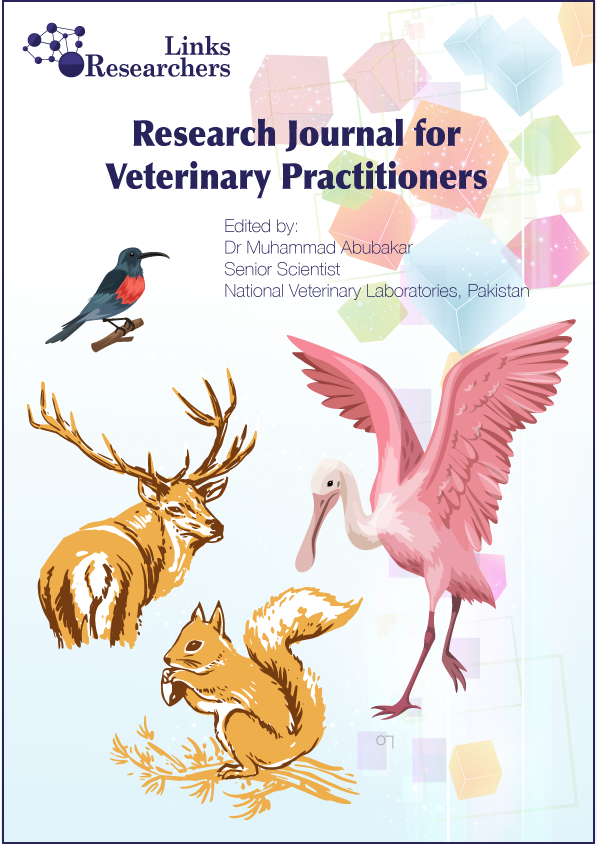Galina N. Leonova1*, Ilya G. Kondratov2, Sergei I. Belikov2
...
Jannatul Noor, Md. Ahaduzzaman, Mir Md. Afzal Hossain, Mohammad Alamgir Hossain, Sardar Abdur Rahim and Md. Samun Sarker
Pam D Luka, Frank N Mwiine, Bitrus Yakubu, Joseph Erume, Ricardo Pérez-Sánchez, Hermann Unger and David Shamaki
Saqib Ali1, Suliman Ali1, Lina1, Wen Zhou1, Muhammad Irfan Waris1, Ashfaq Ali2 and Man Qun Wang1,*
Hussein Aly Hussein1*, Omneya Mohamed Khattab2, Shereen Mohamed Aly2, and Mohammed Abdel Mohsen Rohaim1
Sadaf Shahid1, Abdul Razzaq2, Gul-Makai1, Asim Shamim3*, Hafiz Muhammad Rizwan4, Rana Hamid Ali Nisar5, Qaiser Akram6, Mohsin Nawaz3
Wael Felefel1*, Mohamed EL-Beskawy2, M. F. El -Dakroury3, Mohamed Morsi Elkamshishi4, Eman Sayed Mohammed5
Aiman Batool1, Muhammad Sohail Sajid1,2*, Hafiz Muhammad Rizwan3**, Asif Iqbal4, Imaad Rashid5, Ibadullah Jan6, Faiza Bano7, Fiaz Ahmad8, Waqas Ahmad1, Muhammad Nisar Khan1
Muhammad Usman1*, Aneela Zameer Durrani1, Nasir Mehmood2, Muhammad Hassan Saleem1 and Mamoona Chaudhry3
Hidayat Ullah1, Sadia Tabassum1, Sultan Ayaz2, Shumaila Noreen1, Atta Ur Rehman1, Naveed Akhtar3, Muhsin Ali3, Zaib Ullah3* and Sajid Mahmood1,4
Alisher Safarov1*, Nasreen Nasreen4, Firuza Akramova5, Shukhrat Djabbarov1, Adolat Mirzaeva5, Javokhir Esonboev5, Djalaliddin Azimov5, Mourad Ben Said2,3
Arslan Muhammad Ali Khan1, Rao Zahid Abbas1*, Zia ud Din Sindhu1, Muhammad Shahid Mahmood2
Asma Sadia Authoy2, Aneek Chanda2, Aparna Datta3, Md Shohel Al Faruk4, Towhida Kamal1*
Kalsoom Abdulrazaq1*, Bisma Arif1, Rimsha Mehboob2, Asma Mehboob3
Karima Akool Al-Salihi1*, Luay Jumaah Jihad2, Abbas Najm Aldin Saleh3
Anisa Mushtaq1, Murtaz ul Hasan1*, Asim Shamim2, Muhammad Ali Abdullah Shah1, Muhmamad Arif Zafar3, Abdul Asim Farooq4, Aayesha Riaz1, Muhammad Kamran1 and Saif ur Rehman1
Camilo Romero Núñez1, Galia Sheinberg Waisburd2, Alberto Martin Cordero3, Rafael Heredia Cárdenas1, Laura Miranda Contreras1, Ariadna Flores Ortega4, Linda Guiliana Bautista Gómez5
Md. Asaduzzaman Lovelu1, Md. Amir Hossain2*, Md. Uzzal Hossain1, Tanzila Zafrin Tanvi1, Mahfuza Ferdous3, Nazmin Sultana Runa4, Assrafi Siddika3, Md. Sahidul Islam2
Muhammad Salman1, Rao Zahid Abbas1*, Muhammad Kasib Khan1 and Muhammad Shahid Mahmood2
Zulfiqar Ali1, Asad Ullah2*, Shumaila Gul3, Maryam Begum4, Raheela Taj5, Tahira Tayyeb1, Maiz ur Rahman1, Muhammad Owais Khan1, Rafiq Ullah1, Imad Khan2, Ali Gohar2, Shakirullah Khan6, Khudija Ghani7 and Muneeb Islam8
Wessam Monther Mohammed Saleh1*, Afrah Ali Dakhil2, Saad Shaheen Hamadi Al-Taher3, Mazin Mahdi Naji4, Layth Mohammed Salih AbdulRasool4, Khazaal Abbas Khazaal Alqaisi4
Khakim R. Tukhtaev1, Adolat U. Mirzaeva2*, Firuza D. Akramova2, Orifjon Khamidov3, Ruziboy K. Shapaotov2, Javokhir R. Esonboev2, Shoira O. Saidova2, Angela Monica Ionică5*, Kakali Bhadra4
Md. Roies Uddin, Shib Shankar Saha*, Khondoker Jahengir Alam, Md. Shah Alam and Shampa Rani
Mahfouz M.M. Abd-Elgawad
Marie Claire Komtangi, Paul Junior Detsi, Betrand Kiafon Nsah and Julius Awah-Ndukum*












